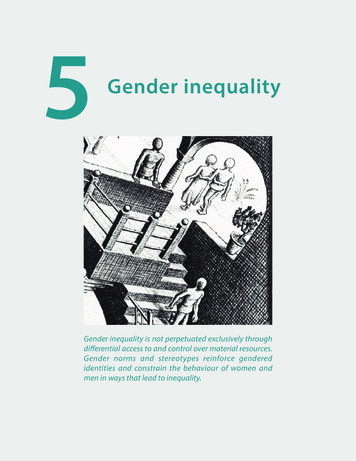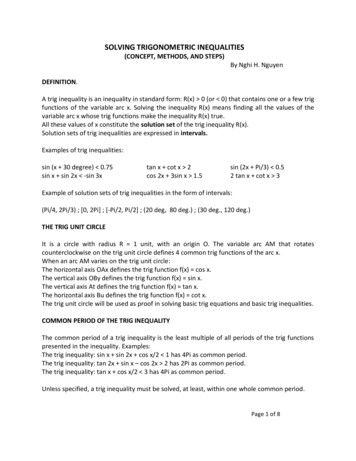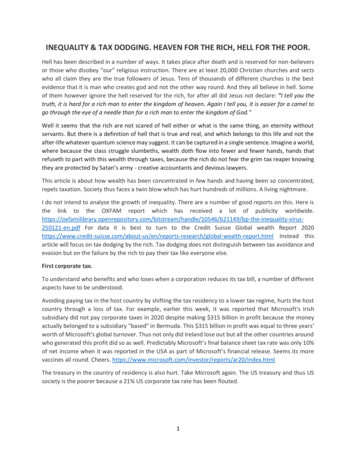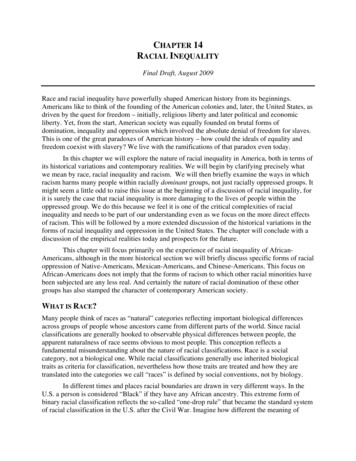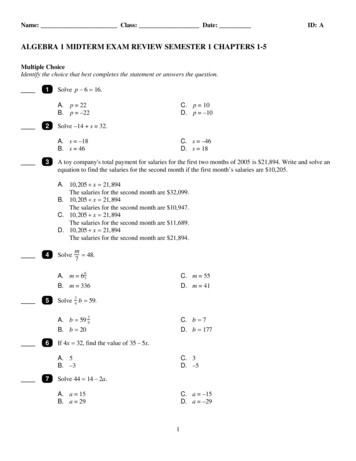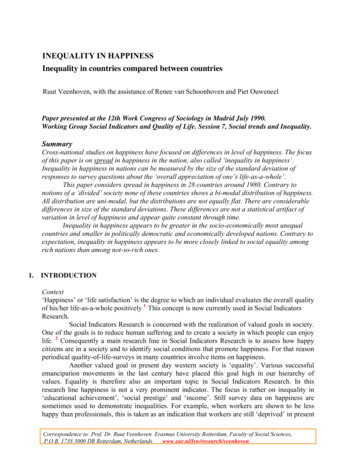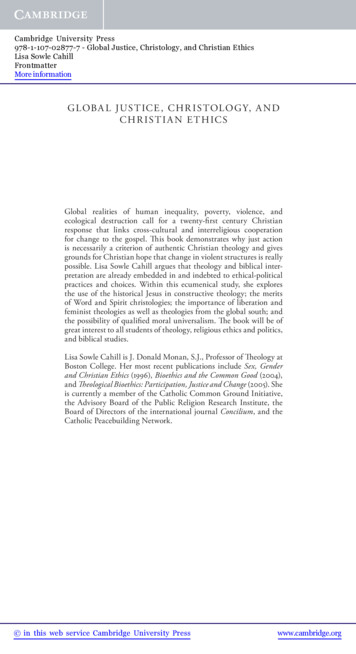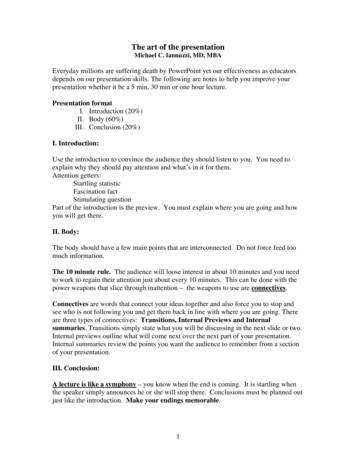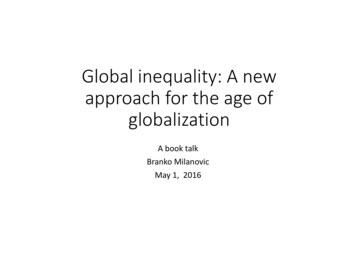
Transcription
Global inequality: A newapproach for the age ofglobalizationA book talkBranko MilanovicMay 1, 2016
The structure of the book
Chapter 1. Current globalization, mid‐1980s totoday: The rise of the global middle class andglobal plutocrats
Real income growth at various percentiles of globalincome distribution, 1988‐2008 (in 2005 PPPs)Real PPP income change (in percent)80X “China’s middle class” PPP270 PPP 18060 PPP4.5 PPP1250403020Branko MilanovicX“US lower middle class”100020406080100Percentile of global income distributionFrom twenty years\final\summary dataEstimated at mean‐over‐mean
Why we do it? Political implications The objective of the work on global inequality is not just a descriptionof the changes but drawing lessons on their political implications Point A raises the issue of future political inclusion of the Chinesemiddle class Point B, of rich countries’ democracy in condition of incomestagnation among many relatively poorer groups Point C, of global plutocracyBranko Milanovic
cumulative real growth rate between 1988 and 2008020406080Global growth incidence curve, 1988‐2008(by percentile)mean growth210Usincg c \twenty years\dofiles\mygraphs20304050607080percentile of global income distributionBranko Milanovic90 95 100
Real income growth over 1988‐2008 and 1988‐2011 (based on2011 PPPs)Cumulative real per capita growth in % between 1988 and 0405060Percentile of global income distributionBranko Milanovic708090100
Global income distributions in 1988 and 2011.8Figure 3. Global income dstribution in 1988 and rging global “middleclass” between 3 and 16log of annual PPP real incometwoway (kdensity loginc 11 11 [w popu] if loginc 11 11 2 & year 1988, bwidth(0.14) title("Figure 3. Global income dstribution in 1988 and 2011")) (kdensity loginc 11 11 [w popu] if loginc 11 11 2 &year 2011, bwidth(0.2)) , legend(off) xtitle(log of annual PPP real income) ytitle(density) text(0.78 2.5 "1988") text(0.65 3.5 "2011") xlabel(2.477"300" 3"1000" 3.477"3000" 4"10000" 4.699"50000",Branko Milanoviclabsize(small) angle(90))Using Branko\Income inequality\final11\combine88 08 11 new.dta
Chapter 2. Inequality within countries:introducing Kuznets waves (cycles) to explainlong‐term trends in income inequality
A1. Kuznets’ cycles in societieswith a stagnant mean income11
How do societies with stagnant mean income look like?25000Seven centuries of GDP per capita in Italy, 1300‐2011GDP per capita in 1990 002000YearData provided by Giovanni Vecchi.12
Cyclical nature of the Kuznets curve:Land rental/wage ratio over the long-term in Spain, 1282-1842140120NapoleonicwarsLand rental/wage ratio100Wool and wine production,rising demand for land,commercialsociety80Wars, decline of 8101822183418460From Prados de la Escosura & Alvarez-Nogal, “The rise and fall of Spain 800-1850”13
Kuznets curve here? No.GDP per capita and rent‐wage ratio: Spain 1325‐1840140120Lad rent/wage ratio10080Land/wage 60402000102030405060708090100GDP per capita (1859‐100)From Prados de la Escosura & Alvarez‐Nogal, “The rise and fall of Spain 800‐1850”14
Key idea & key difference between pre‐industrial and industrial societies Kuznets cycles in pre‐industrial societies are visible only over time(since income is quasi fixed). They are mostly driven by non‐economic changes: conquests, wars, epidemics. Link between Kuznets and Malthusian cycles in pre‐industrialsocieties; but Kuznets cycles are broader because they are notnecessarily driven by demographic changes Little room for large increases in inequality because the averageincome level was very low (recall the inequality extraction ratio:inequality is limited by the level of average income)15
A2. Kuznets’ cycles in societieswith a rising mean income16
Kuznets waves defined Kuznets waves in modern societies are visible whenplotted against income per capita. Inequality driven bytechnological innovation and structural transformation(two technological revolutions), globalization and politicsand policies. But also wars. Cyclical movement of inequality: long Kuznets waves,often over fifty years Kuznets saw just one curve. We now know there may bemany more.17
Malign and benign forces reducing inequality(downward portion of the Kuznets wave)MalignBenignSocieties with stagnantmean incomeIdiosyncratic events: wars(though destruction),epidemics, civil conflictCultural and ideological (e.g.Christianity?)Societies with a risingmean incomeWars (through destructionand higher taxation: Warand Welfare), civil conflict Widespread education(reflecting changing returns) Social pressure throughpolitics (socialism, tradeunions) Aging (demand for socialprotection) Low‐skill biased TC Cultural and ideological (paynorms?)18
Kuznets relationship for the UK, 1688‐20106018671913Gini of disposable per capita 00200002500030000GDP per capita (in 1990 international dollars; Maddison)Source: Ginis: for 1688, 1759, 1801, and 1867 from social tables for England/UK (as reported in Milanovic, Lindert and Williamson); for 1880 and 1913, from Lindert and Williamson(1983, Table 2); from 1961 to 2010, official UK data (disposable income per capita) kindly calculated by Jonathan Cribb, Institute for Fiscal Studies. GDP per capita from Maddisonproject 2014 version.US and uk.xls19
Kuznets relationship for the United States, 1774‐20136018601933501929Gini of disposable per capita 0250003000035000GDP per capita (in 1990 international dollars; Maddison)Source: Ginis: 1774 and 1860 from social tables created by Lindert and Williamson (2013). 1929. Radner and Hinricks (1974); 1931 and 1933: Smolemsky amnd Plotnick (1992). GDP per capitafrom Maddison project 2014 version. From 1935 to 1950 from Goldsmith et al (1954); from US Census Bureau, Income, poverty and health insurance coverage in the United States (variousissues); gross income data adjusted to reflect disposable income.20
Kuznets relationship for Italy, 1861‐201060.01861Gini of disposable per capita 10000150002000025000GDP per capita in 1990 international dollars; Maddison)21Source: Ginis: from 1861 to 2008 from Brandolini and Vecchi (2011) and personalu communication; for 2010 from LIS. GDP per capita from Maddison project 2014 version
Kuznets waves look more dramatic in logs Kuznets relationship for the United States, 1774‐2013601860193350Gini of disposable per capita income19292013177440194719793020100100010000GDP per capita (in 1990 international dollars; Maddison)100000
Kuznets relationship for the UK, 1688‐20106018671913Gini of disposable per capita income5016884020101993301962197820100100010000GDP per capita (in 1990 international dollars; Maddison)100000
Downswing of Kuznets first cycle and upswing ofthe second Kuznets cycle in advanced economiesLevel ofmaximuminequality (peakof Wave 1)Gini points(year)Level ofminimuminequality(trough of Wave1)(year)United States51 (1933)35 (1979)50UK57 (1867)27 (1978)Spain53 (1918)ItalyApproximateReduction innumber of years inequality (Giniof downswing of points)the KuznetswaveGDP increased(how manytimes) duringthe downswingThe secondKuznets wave(increase in Ginipoints)164Strong ( 8)11030 4Strong ( 11)31 (1985)7022 5Modest ( 3)51 (1851)30 (1983)12021 9Strong ( 5)Japan55 (1937)31 (1981)45246Modest ( 1)Netherlands61 (1732)21 (1982)250357Modest( 2)24
Average per decade real per capita growth and Gini change during thedownward portion of the first Kuznets wave (the Great Levelling)0010203040506070‐1Average change in Gini points per decadeNetherlands 1732‐1982‐2‐3Italy 1861‐1983UK 1867‐1978USA 1933‐1979‐4‐5Japan 1937‐1981‐6‐7Spain 1953‐1985‐8Average real per capita growth rate per decade25
What drives 1st Kuznets cycle down and 2nd Kuznets cycle up?Downward portion of Kuznets 1 1900 to 1980Malign forces(wars) Wars Hyperinflation (against creditors)Benign forces(economics,social,demography) Social pressure through politics(socialism, trade unions) High taxation Widespread education Aging (demand for social protection)Upward portion of Kuznets 21980‐? Movement of labor from manufacturinginto heterogeneous services Rents from tech innovations Globalization Technological change Free global movement of capital Policy changes (endogenous) TOP impossible to disentangle26
Brazil, China’s inequality in theKuznets framework5060Brazil40GiniChina050001000015000GDP per capitatwoway (scatter Giniall gdpppp if contcod "CHN" & year 1960, connect(l) ylabel(40(10)60) xtitle(2000 6000 12000) ytitle(Gini) xtitle(year)) (scatter Giniall gdpppp if contcod "BRA", connect(l) text(6212000 "Brazil") text(48 12000 "China") legend(off))Using gdppppreg5.dta27
“Endogeneity” of World War I Domestic maldistribution of income High profits and insufficientdomestic demand Foreign investment Need to control territorieswhere investments are made Large armies The same logic applied by each power leads to conflict “The actual practice has been for business men to secure the assistance oftheir governments in pushing for markets, investments, and concessionsoutside their own country, in competing with business men of other nationssimilarly supported by their governments, and in bringing diplomatic orpolitical pressure to bear on the government or people of any weak countrywhere their trading or other economic interests are threatened. It is thisillicit and underhand use of foreign policy by private business interest whichhas converted economic internationalism into the peril it has shown to be.(Hobson, The evolution of modern capitalism: a study of machineproduction, pp. 492‐3)
From ThomasHauner
Chapter 3. Inequality between countries: fromKarl Marx to Frantz Fanon and back to Marx?
La longue durée: Global inequality From Karl Marx to Frantz Fanon and back toMarx?80LocationProjectionsGini 018502011Branko Milanovic2050
Issues of justice and politics1. Citizenship rent2. Is global equality of opportunity an objective to pursue?3. Migration, citizenship and national welfare stateBranko Milanovic
Global inequality of opportunity Regressing (log) average incomes of 118 countries’percentiles (11,800 data points) against countrydummies “explains” 77% of variability of incomepercentiles Where you live is the most important determinant ofyour income; for 97% of people in the world:birth citizenship. Citizenship rent or citizenship premiumBranko Milanovic
Is citizenship a rent? If most of our income is determined bycitizenship, then there is little equality ofopportunity globally and citizenship is a rent(unrelated to individual desert, effort) Key issue: Is global equality of opportunitysomething that we ought to be concerned ornot? Does national self‐determination dispenseswith the need to worry about GEO?Branko Milanovic
Rawls’ views on inter‐generational transmission of wealthGroupInter‐generationaltransmission ofcollectivelyacquired wealthArgumentPolicyFamilyNot acceptableOr at least to belimitedThreatensequality ofcitizensModerate to veryhigh inheritancetaxNationAcceptableAffirms nationalself‐determination(moral hazard)International aidBranko Milanovic
Migration: a different way to reduce globalinequality and citizenship rent How to view development: Development isincreased income for poor people regardless ofwhere they are, in their countries of birth orelsewhere Migration and LDC growth thus become the twoequivalent instruments for developmentBranko Milanovic
Growing inter‐country income differences and migration:Key seven borders todayBranko Milanovic
The logic of the migration argument Population in rich countries enjoys the citizenship premium They are unwilling to share, and thus possibly reduce (at least“locally”) this premium with migrants Currently, the premium is full or 0 because citizenship is(broadly) a binary variable Introduce various levels of citizenship (tax discrimination ofmigrants; obligation to return; no family etc.) to reduce thepremium This should make native population more acceptant of migrantsBranko Milanovic
Trade‐off between citizenship rights andextent of migrationFullcitizenrightsSeasonal workers(almost 0 rights)0* People who would like to migrate accordingto a world‐wide Gallup poll13% of worldpopulation*Branko MilanovicMigration flow
Chapter 4. Global inequality in this century andthe next
Interaction of mean income convergenceand Kuznets waves1. Will convergence economics spread to Africa?2. Evolution of income inequality in the US and China3. Hollowing out of the Western middle classes: populism vs.plutocracy4. Global reminder: capitalism the only existing social systemBranko Milanovic
Annual per capita after‐tax income in international dollarsUS 2nd decile5000Chinese 8thurban decile5001988From summary data.xls19931998200320082011
.08US and China’s growth at the same income level(GDPpc in Maddison’s 1990 PPP)20111981growth rate.04.06China.021941USA0180002000400060008000GDP per capita in 1990 G-K dollars10000twoway (lowess growth gdpppp if contcod "CHN" & year 1980) (lowess growth gdpppp if contcod "USA" & gdpppp 9000, text(0.07 1980 "China")text(0.015 1950 "USA") legend(off) xtitle(GDP per capita in 1990 G‐K dollars) ytitle(growth rate))Using Polity Maddison 2013.dta
Difference in the combined (population‐weighted) growth rates of the large emerging economies (excluding China) andrich countries, 1951‐2014:-.1percentage point growth rate gap-.050.05.1Since the mid 1980s rich economies have never grown faster than large emerging economies, even excludingChina194019601980year20002020Large emerging economies are India, South Africa, Brazil, Indonesia and Vietnam.c:\branko\new book\figures chapter 4 5 bookUsing gdppppreg5.dtaBranko Milanovic
The US “perfect storm” Rising share of capital income in total net income Unchanged or increased concentration of capital ownership (Gini is inexcess of 85) Increased association between high capital and labor incomes (seethe next slide; Atkinson and Lakner) Continued or increased homogamy (assortative mating): the processwhich goes on for some 30 years (Greenwood et al.) Continued or increasing ability of the rich to “buy” policies (Bartels,Page)45
Gini coefficients of capital and labor income: US 1974‐20131.0Capit0.90.80.70.60.50.41970Based on LIS data;us87 13 15
Probability (in percent) of being in top 10% by capital (labor) income if aperson is in top 1% by labor (capital) income70If in top 1% by labor income60If in top 1% by capital income504030201001980Lakner and Atkinson (2015)1990200047
Stylized correlation between capital and laborincome in history (across persons)Correlation coeff.“New capitalism”Socialism0Classic capitalismCapitalists begin towork; labor getssome K income
Policy responsiveness to the divergent preferencesof the rich, middle class and the poorFrom Martin Gilens, Affluence and Influence49
The “plateaing ” of the urban Gini in China, 1981‐2014Urban Gini in China: 1981‐2014 (based on officialhousehold surveys)0.350.3Urban 5949392919089888786858483820810.05YearCalculated from Chinese urban household surveys (published data)50
Where are now China and the US?GiniFirst Kuznets waveChina 2013Second Kuznets waveUnited States2013GDP per capita
What might drive the 2nd Kuznets cycledown? Progressive political change (endogenous: political demand) Dissipation of innovation rents Low‐skilled biased technological progress (endogenous) Reduction of the skill premium as education expands further (but Iam skeptical of its relevance) Global income convergence: Chinese wages catch up with Americanwages: the hollowing‐out process stops (but other poor countries onthe horizon )52
Is this an optimistic or pessimistic theory ofchanges in income inequality? The question boils down to whether there are endogenous forcesthat would curb and check increase in income inequality undercapitalism Such forces can be benign: political pressure and greater taxation,ideology, low‐skill biased technological change, greater supply ofeducated labor, aging population and demand for social services Or they can be malign: as they were in the run up to World War Iwhere insufficient domestic demand led to the competition forcontrol of colonies (imperialism) and ultimately war Such forces cannot be excluded today.53
Chapter 5. What next? Ten short reflections onglobal inequality(here: only one)
.6The 21st century reduction of inequality should rely less omredistribution of current income and more on equalizationof labor and capital endowmentsdisposable income Gini.3.4.5market Gini disposable GIniISRUSAGBRTWN KORESP GRCITAAUSCANJPNLUXIRL FRADEU.2NLDFINNORDNK.3.4.5market income Gini.6
Policy implications (summarized)
Focus on deconcentration of asset ownership (ESOPs, special taxbenefits for small investors) and equalization of returns to education(public education) Thus, focus on pre‐distribution and taxation of inheritance rather thanincreased redistribution of current income (i.e., working onequalization of stocks rather than on flows) European welfare state’s ability to combat increased inequality by“traditional tools” of taxes and transfers is limited by (i) increasedethnic and cultural heterogeneity and (ii) mobility of capital and highincome earners Reform of political funding More diverse forms of citizenship (to allow for greater migration) Multilateral migration quotas Movement away from single‐minded pursuit of horizontal equality
Glossary of new terms “Elephant graph” Kuznets waves in pre‐modern and modern societies Malign and benign forces that reduce inequality Endogeneity of World War I Citizenship rent or premium Trade‐off between citizenship as a binary category andreduction of global inequality and poverty Focus on deconcentration of asset ownership
dummies "explains" 77% of variability of income percentiles Where you live is the most important determinant of your income; for 97% of people in the world: birth citizenship. Citizenship rent or citizenship premium Branko Milanovic
